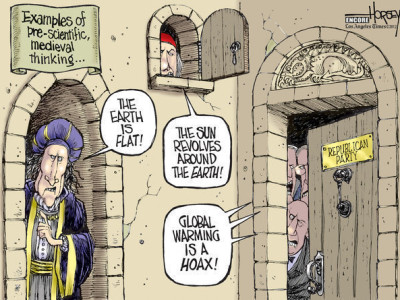The Global Convergence of Disaster Law and Climate Law
Two very distinct areas of international law are finding more and more in common.
International climate negotiations may seem to have little to do with the work of such international relief organizations as the Red Cross. On the national level, EPA and FEMA are two very different agencies that historically have had little connection. The same has been true at the international level. But disaster and climate authorities are finding more and more reasons to work together. Correspondingly, as I discuss in a recent paper, the areas of international law governing climate change and disaster response are beginning to converge.
Scientists project serious increases in society’s exposure to extreme weather events as a result of climate change. Indeed, they have begun to link current disasters to climate change. Sticking to recent events, just in the recent weeks we’ve seen the California wildfires, along with many other wildfires in the West, and the rapid intensification of Hurricane Laura as it neared the coast. Both have been linked to climate change.
“Attribution” is a rapidly developing area of climate science. Scientists have found connections with climate change for many situations involving heat waves, storms, wildfires, and droughts. Two disasters that seem to have clear links to climate change are heat waves in Europe and Russia earlier in this century that between them may have killed as many as 100,000 people. We can expect disaster threats to escalate as the planet continues to warm, posing ever greater challenges to human societies.
International disaster law (IDL) predates the start of climate change. The first discussion of the responsibility of the international community to respond to disasters traces back to the Great Lisbon Earthquake of 1755 . The advent of climate change raises the ante for both nations and the international community in responding to disasters. International disaster law has begun to take account of climate change. of disaster law has begun to acknowledge the importance of taking account of climate change in disaster risk management.
The Sendai Framework for Disaster Risk Reduction 2015-2030 recognizes that “addressing climate change as a driver of disaster risk . . . represents an opportunity to reduce disaster risk in a meaningful and coherent manner throughout the interrelated intergovernmental processes.” The following year, the International Law Commission issued Draft Articles on disaster response that stressed the duty of nations to mitigate disaster risks rather than focusing solely on responding after the fact. Climate change will necessarily be a central factor in assessing risks and planning mitigation measures.
Simultaneously, climate negotiations are beginning to address disasters as a form of “loss and damage,” and more broadly under the rubric of climate change adaptation.
Although international climate negotiations still focus heavily on measures to cut carbon emissions, disaster issues have also begun to enter the conversation. The need for countries to adapt to unavoidable climate change has received increasing prominence in the negotiations. There has been particular interest in funding adaptation measures in the poorest countries, which are often highly exposed to climate threats but lack the resources to deal with them. Because disasters figure so heavily among the threats posed by climate change, managing disaster risks is a key adaptation task. An emerging topic at the negotiations is “loss and damage,” meaning what to do about harms that cannot be avoided through adaptation. Countries with high emissions resist the idea of paying compensation for the harms inflicted by climate change, but there is active discussion of other ways to cushion the blows of disasters and other climate-related impacts.
Both fields of law can be strengthened by this trend. Although wealthier countries can be generous after a disaster has struck, it can be difficult to obtain funding for disaster prevention. As a form of climate adaptation, disaster prevention may be able to tap new sources of funding. To effectively deal with the enhanced risks of disasters due to climate change, climate negotiators need the benefit of the expertise and expertise developed by disaster agencies and experts in international disaster law. A greater focus on disasters may also help provide more of a focus to climate negotiations. Unfortunately, it appears that we are going to see more climate change on the one hand, and more frequent and severe disasters on the other. So the overlap between these two fields of law will become ever more important.







Reader Comments